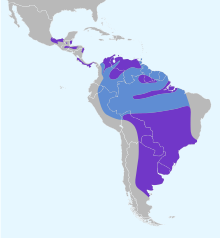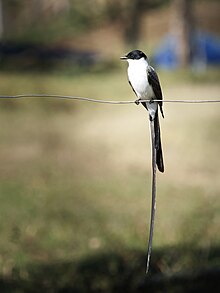Fork-tailed flycatcher
| Fork-tailed flycatcher | |
|---|---|

| |
| Male T. s. monachus in Belize | |

| |
| Female T. s. monachus in Panama | |
| Scientific classification | |
| Domain: | Eukaryota |
| Kingdom: | Animalia |
| Phylum: | Chordata |
| Class: | Aves |
| Order: | Passeriformes |
| Family: | Tyrannidae |
| Genus: | Tyrannus |
| Species: | T. savana
|
| Binomial name | |
| Tyrannus savana Daudin, 1802
| |

| |

The fork-tailed flycatcher (Tyrannus savana) is a
Taxonomy
The fork-tailed flycatcher was described in 1760 by
Four subspecies are recognised:[8]
- Tyrannus savana monachus Guianas, and northern Brazil
- Tyrannus savana sanctaemartae (Zimmer, JT, 1937) – northern Colombia and northwest Venezuela
- Tyrannus savana circumdatus (Zimmer, JT, 1937) – east-central Brazil
- Tyrannus savana savana Daudin, 1802 – central, southern South America and the Falkland Islands
-
in flight
-
showing fork tail
Description
The fork-tailed flycatcher is white below, gray above, and has a black cap. Males sometimes show a yellow crown stripe. Males also have an extremely long, forked tail, of even greater length than that of the related scissor-tailed flycatcher. Females have a somewhat shorter tail, and it is significantly shorter in juveniles. Males are 37–41 cm (15–16 in) in length; females, 28–30 cm (11–12 in), including tail. They weigh only 28–32 g (0.99–1.13 oz), much less than closely related kingbirds, which are half the total length of this species. The tail in adult males is two to three times longer than the length of the bird from the bill to the base of the tail. Generally, males and females of the species look quite similar, but can be distinguished by the longer tail in males.[9]
The
Most fork-tailed flycatchers are migratory, but some stay year-round, especially in southern Mexico. Migratory fork-tailed flycatchers tend to have more pointed wings than nonmigratory flycatchers.[11]
Vocalizations
Fork-tailed flycatchers produce both vocal and nonvocal sounds. In general, they have a dry, buzzy call, and a weak "tic-note" while in flight.[12]
Their wings have been observed to make a distinct whistling note while flying overhead. In fact, research has been conducted involving distinct differences in the pitch of whistling noises by different subspecies of T. savana. This recent research has pointed towards a hypothesis that fork-tailed flycatchers are splitting into two distinct species, as the nonmigratory birds have a much-lower-pitched whistling note than the migrators. This becomes another observed difference amongst others (e.g. wing shape) pointing to the two-species conclusion.[13]
During mating displays, the males' wings may also make dry, crackling sounds; further research has investigated the use of these wing noises in potentially startling predators or would-be nest parasites (e.g. shiny cowbird).[9]
Distribution and habitat
Fork-tailed flycatchers are usually found below 1000 m elevation where they occur in a wide variety of habitats including pastures, riparian forests, forest edges, mangroves, and open residential areas with scattered trees. During migration, however, T. savana may be found in an even broader range of habitats.[14]
Its breeding range is from central Mexico to central Argentina. In most of this range, it is usually found year-round, but in the southern parts of its range, it retreats northward for the winter.
During migration, fork-tailed flycatchers are quite gregarious, nesting in flocks of up to 10,000 individuals.[15][16] This species is known to wander widely. It is spotted almost annually in the eastern United States seaboard and Canada, normally around fall (September–November).
During migration, fork-tailed flycatchers have been observed flying accompanied by relative species such as eastern kingbirds and aggressively chasing off predators.[17]
The nominate subspecies, T. s. savana, is found in central and southern Brazil, Bolivia, Paraguay, Uruguay, and Argentina (south to the
Behavior
Breeding
Males perform aerial courtship displays involving swirling somersaults, twists, and flips. All partnered with their buzzing calls, they do their best to impress female counterparts.[9] Courtship displays also provide a usage for their long tail feathers (which are longer in males), as a way to impress potential mates.[19] Breeding seasons are dependent on subspecies and location; breeding season ranges from late summer to mid-winter.[16]
Fork-tailed flycatchers tend to build their cup nests in similar habitats to their hunting grounds (riparian forests, grasslands). They tend to prefer specific trees in specific geographic locations, such as Kielmeyera trees in central Brazil. The clutch is 1–3 eggs.[20]
Diet
This species is primarily an insectivore but will switch to berries and small fruits during winter if insects become scarce. Fork-tailed flycatchers sally from their perches to eat flying insects or glean them off of leaves and fruit. When insects become less available in winter months, they have been observed eating fruits.[16]
Fork-tailed flycatcher's long tail is an important asset in their hunt for arthropods. The long tail allows them to turn on a dime and sally after prey. In fact, fork-tailed flycatchers – though small and light – can reach speeds up to 65 miles per hour (105 km/h) and stop/turn impressively quickly using their flashy tails.[19]
References
- . Retrieved 12 November 2021.
- ^ Brisson, Mathurin Jacques (1760). Ornithologie, ou, Méthode Contenant la Division des Oiseaux en Ordres, Sections, Genres, Especes & leurs Variétés (in French and Latin). Vol. 2. Paris: Jean-Baptiste Bauche. pp. 395–398.
- ^ Buffon, Georges-Louis Leclerc de (1780). "Le Savana". Histoire Naturelle des Oiseaux (in French). Vol. 14. Paris: L'Imprimerie Royale. pp. 557–558.
- ISBN 978-1-4081-3326-2.
given […] by de Buffon […] because it inhabited flooded savanna grasslands
- JSTOR 4069359.
- hdl:2246/3860.
- ^ Traylor, Melvin A. Jr, ed. (1979). Check-List of Birds of the World. Vol. 8. Cambridge, Massachusetts: Museum of Comparative Zoology. p. 226.
- Rasmussen, Pamela, eds. (July 2020). "Tyrant flycatchers". IOC World Bird List Version 10.2. International Ornithologists' Union. Retrieved 21 January 2021.
- ^ ISSN 0033-5770.
- S2CID 84007606.
- S2CID 49864430.
- S2CID 86322564.
- PMID 32777043.
- PMID 10082611.
- ^ Jahn & Tuero, A, D. (March 4, 2020). "fork-tailed flycatcher". Birds of the World.
{{cite web}}: CS1 maint: multiple names: authors list (link) - ^ , retrieved 2020-09-26
- S2CID 242506188.
- S2CID 86322564.
- ^ ISSN 0273-8570.
- .
External links
- "Fork-tailed flycatcher media". Internet Bird Collection.
- Fork-tailed flycatcher Stamps[usurped] from Argentina, Brazil, Falkland Islands, Grenada, Trinidad and Tobago, and Uruguay at bird-stamps.org[usurped]
- Fork-tailed flycatcher photo gallery at VIREO (Drexel University)
- Fork-tailed flycatcher Photo at John Kormendy's Birds of Brazil website
- BirdLife species factsheet for Tyrannus savana
- Fork-tailed flycatcher species account at Neotropical Birds (Cornell Lab of Ornithology)
- Interactive range map of Tyrannus savana at IUCN Red List maps
- Audio recordings of Fork-tailed flycatcher on Xeno-canto.
- Citizen science observations for Fork-tailed flycatcher at iNaturalist



